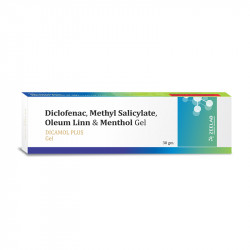Smart Medicine Comparison
Recommended Substitute
You Searched

Diclosin Gel
77% More Savings

Why Choose our Dicamol Plus Gel 30 gm ?
Save ₹ 85 - Enjoy up to 77% More Savings
Same Salt, Dosage & Strength as Diclosin Gel
Crafted in a WHO-GMP Certified Facility
President Award Winner - Trusted by Millions




Detail Comparison
| Parameter | Diclosin Gel | Dicamol Plus Gel 30 gm |
|---|---|---|
| Composition | Diclofenac diethylamine (1.16% w/w) + Methyl Salicylate (10% w/w) + Oleum Lini (3% w/w) + Menthol (5% w/w) | Diclofenac+Methyl Salicylate+Oleum Linn+Menthol Gel |
| Quantity | 30 gm Gel | 30 gm in 1 tube |
| Price | ₹ 110 High Price |
₹ 25 Save 77% |
| Prescription required | Yes | Yes |


 Added!
Added!